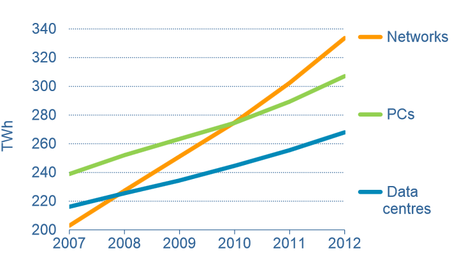 The IEA has released the “More Data, Less Energy: Making Network Standby More Efficient in Billions of Connected Devices” report.
The IEA has released the “More Data, Less Energy: Making Network Standby More Efficient in Billions of Connected Devices” report.According to the latest report by the International Energy Agency (IEA), the world’s 14 billion online electronic devices waste around $80 billion per year due to low energy efficiency.
By 2020, the problem will considerably worsen, with an estimated $120 billion wasted. But a report by the International Energy Agency points to a different path, identifying simple measures that can be implemented now to improve energy efficiency in online devices, resulting in massive savings of energy and money.
SEE ALSO: IEA: World’s Energy Needs Will Cost $48 Trillion by 2035

Electricity demand of networks, PCs and data centres. Electricity demand of ICT is growing at a much faster rate than overall electricity
demand. (Credit: OECD/IEA, 2014)
The report, More Data, Less Energy: Making Network Standby More Efficient in Billions of Connected Devices, shows that electricity demand of our increasingly digital economies is growing at an alarming rate. While data center energy demand has received much attention, of greater cause for concern is the growing energy demand of billions of networked devices. In 2013, a relatively small portion of the world’s population relied on these devices to stay connected. But energy demand is increasing as a growing share of the world’s population becomes wired and as network connectivity spreads to devices and appliances that were previously not connected, such as washing machines, refrigerators, lights and thermostats.
“The proliferation of connected devices brings many benefits to the world, but right now the cost is far higher than it should be,” said IEA Executive Director Maria van der Hoeven. “Consumers are losing money in the form of wasted energy, which is leading to more costly power stations and more distribution infrastructure being built than we would otherwise need—not to mention all the extra greenhouse gases that are being emitted. But it need not be this way. If we adopt best available technologies we can minimize the cost of meeting demand as the use and benefits of connected devices grows.”
As the report explains, much of the problem boils down to inefficient “network standby”—that is, the maintaining of a network connection while in standby. In many online devices, standby is a misnomer: it suggests that the device has gone to sleep and is almost off. In reality, most network-enabled devices draw as much power in this mode as when activated to perform their main tasks.

ICT electricity demand by segment and Network-enabled device electricity demand. (Credit: OECD/IEA, 2014)
In 2013, the world’s networked devices consumed around 616 terawatt hours (TW·h) of electricity, the majority of which was used in standby mode. Of that total, around 400 TW·h—equivalent to the electricity consumed annually by the United Kingdom and Norway combined—was wasted because of inefficient technology.
“The problem is not that these devices are often in standby mode, but rather that they typically use much more power than they should to maintain a connection and communicate with the network,” said Ms. Van der Hoeven. “Just by using today’s best available technology, such devices could perform exactly the same tasks in standby while consuming around 65% less power.”
The report describes technologies and technical solutions as well as a range of policy options that are available to reduce energy waste. It projects that if better energy efficiency measures were applied to online devices in the coming years, 600 TWh of energy would be saved. That’s equivalent to shutting 200 standard 500 MW coal-fired power plants, which would cut emissions by 600 million metric tons of CO2.
In the report, the IEA calls on policy makers, standards development organizations, software and hardware developers, designers, service providers and manufacturers to work together to reduce energy demand. To achieve this, the agency urges an international initiative to enhance standards, as the issue is global.

